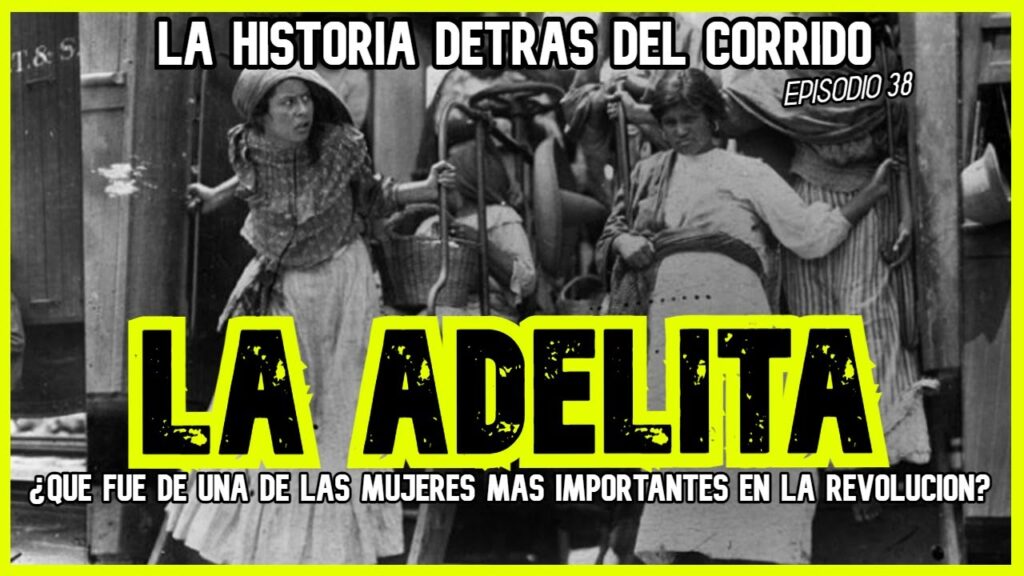The Mysterious Beginnings of La Adelita
The legend of La Adelita is woven deeply into the fabric of Mexico’s revolutionary history, shrouded in the mists of time and tales passed down through generations. Often romanticized in corridos (Mexican ballads), La Adelita came to represent the archetype of a woman warrior, symbolizing the vital contributions of women during the Mexican Revolution. The stories tell of her courage, her strength, and the enigmatic beginnings that contributed to her status as an almost mythical figure.
Despite the numerous renditions of her story, the true origin of La Adelita remains a point of conjecture among historians and cultural enthusiasts alike. Some believe she was a composite of various female soldiers, known as Soldaderas, who joined the fight either in support of their loved ones or to champion the cause for freedom and equality themselves. These women, performing both combat roles and vital support functions, became integral to the revolutionary forces.
Alternatively, some narratives focus on a single inspirational figure – a young woman whose passion and dedication to the revolution transcended personal hardship and struggle. It is claimed that her beauty and bravery captivated the hearts of the fighters, eventually earning her the name “Adelita,” which became synonymous with the idealized image of a woman in the revolution. Yet, no single historical record conclusively details her life, making her beginnings as shadowy as they are intriguing.
Regardless of her precise historical roots, the essence of La Adelita’s character continues to inspire. Her mysterious beginnings only enhance the fascination and draw toward her persona, leading to a rich tapestry of artistic interpretations and scholarly inquiries. La Adelita represents not just a single woman, but the collective spirit and determination of all women who stood boldly in the face of adversity during one of Mexico’s most turbulent eras.
La Adelita: The Iconic Female Figure in The Mexican Revolution
The Story of La Adelita and Her Impact on Mexican Culture
The tale of La Adelita takes us back to the tumultuous times of the Mexican Revolution, a period marked by social and political upheaval between 1910 and 1920. Adelita is not the name of one single woman, but rather a symbol of the fearless soldaderas – women who played an integral role in the fight for justice and equality. The concept of Adelita sprang forth from a popular revolutionary corrido, a kind of ballad, that told the story of a woman whose passion and courage were as firing as the bullets of the revolution itself.
La Adelita has evolved far beyond a simple character in a song to become an enduring icon of Mexican culture. Portrayed as both lover and warrior, she is celebrated for her strength and resilience. The image of La Adelita, dressed in traditional garb, a bandolier slung across her chest, and a sombrero atop her head, has become a quintessential representation of the powerful contribution of women during times of conflict. Her legend has inspired countless works of art, literature, and cinema, thus perpetuating her narrative through the generations.
The influence of La Adelita within Mexican culture can particularly be seen every November during the commemoration of the Mexican Revolution. Festivities often include reenactments and performances where women attire themselves as the famed Adelitas, donning period uniforms and singing ballads that echo the spirits of the brave women of the revolution. Their portrayals serve as vivid reminders of the important role these female revolutionaries played, not only as caregivers and supporters of the male soldiers but as vital fighters in their own right.
In contemporary Mexico, La Adelita is also used as a feminist symbol, celebrating the ongoing struggle for women’s rights and gender equality. Her image is invoked in marches and demonstrations, her essence serving to galvanize women from all walks of life to stand up for their beliefs. The story of La Adelita has transcended its origins to become a rallying cry for female empowerment and a representation of the indomitable will of women in the face of adversity.
Today, the term “Adelita” has woven itself into the very social fabric of Mexico, embodying the fearless spirit of the country’s heroines. Educational curricula include stories of La Adelita to teach children about equality and bravery. Moreover, “Adelita” is a term affectionately used to refer to strong, courageous women who stand up for their rights and for those of others, continuing to fuel the legendary status of this cultural icon.
Unraveling the Legend: Who Was the Real Adelita?
The tale of Adelita transcends time and history, becoming a vibrant symbol of courage and resilience in the Mexican Revolution. The story of Adelita, or Las Adelitas as some narratives suggest, represents the women who participated in the struggle, often recounting their efforts and sacrifices. While the name Adelita has been romanticized through Mexican corridos (folk songs), pinpointing who the real Adelita was remains a challenge for historians and enthusiasts alike.
According to popular lore, Adelita was not merely one woman but an archetype representing the soldaderas—the female soldiers who cooked, cared for the wounded, and even fought alongside men during the Mexican Revolution. These women, like Adelita herself, were bound by a common thread of bravery as they navigated the tumultuous landscape of war. Nevertheless, the character of Adelita is believed to be inspired by a particular woman, though her true identity is shrouded in mystery and folklore.
Some accounts suggest that Adelita was a composite of the experiences of many women, reflecting the collective strength and valor of the soldaderas. It was through their determination and tenacity that the soldiers remained steadfast and focused. The presence of women such as Adelita on the battlefield challenged traditional gender roles of the time and paved the way for future generations of Mexican women to draw inspiration from their remarkable legacy.
Today, the legend of Adelita lives on in the hearts and minds of the Mexican people. While it may be impossible to name the one true Adelita, the spirit she embodies is clear: a fierce, independent, and passionate individual, whose memory is honored through stories, music, and cultural celebrations. As we delve deeper into the past, it becomes evident that Adelita was more than a person—she was the personification of female empowerment during an era of revolution and change.
La Adelita and Her Role in the Fight for Mexico’s Freedom
The name “La Adelita” has become synonymous with the image of a woman warrior in the Mexican Revolution, an armed female figure who not only cared for the wounded and cooked for the revolutionary soldiers but also actively participated in the battle for freedom. The ballad “La Adelita”, one of the most famous corridos (folk songs) to emerge from the Revolution, pays homage to these courageous women, painting a picture of a fearless female who inspired love and bravery amongst the fighting men.
Historically, “Adelitas” or “soldaderas” were women who joined the ranks of men in the quest to overthrow the dictatorship of Porfirio Díaz. These women came from various backgrounds, some driven by idealism, others seeking to escape their social conditions, while some followed their husbands or lovers to war. Regardless of motivation, their contribution was invaluable, serving both in support roles and in combat, making them an integral part of the revolutionary forces.
The figure of La Adelita, while somewhat romanticized, highlights the significant role played by women in the Mexican Revolution. Far from being passive observers, these women displayed immense courage and independence. Their role often went unrecognized, but their contribution laid the groundwork for modern feminist movements in Mexico, challenging traditional gender roles and advocating for rights and recognition within a militaristic context.
Involvement in combat was not the only role for women like Adelita; they also played a key part in espionage, carrying messages between battalions, and some even ascended to officer status. These exploits brought a dual advantage: they proved that women were capable of leadership and strategic thinking, and they served as key operatives in an intelligence network that was crucial to several victories against the federal army.
The spirit of La Adelita lived on after the Revolution, becoming a symbol of female empowerment and perseverance. Memorials and stories celebrating the unsung heroines of the Mexican Revolution continue to inspire women across Mexico today. While the romantic image of La Adelita may vary from the historical reality, her legend remains a powerful representation of women’s involvement in the fight for Mexico’s freedom.
From Folk Song to Feminist Symbol: The Evolution of La Adelita
The figure of La Adelita is one of the most enduring icons to emerge from the tumultuous period of the Mexican Revolution. Initially, she was immortalized in a popular folk song that told the story of a woman soldier who fell in love with a sergeant and followed him into battle. This image has since evolved, transforming Adelita from a mere character in a folkloric tale into a potent symbol of female empowerment and resistance.
During the early 20th century, the corrido of “La Adelita” became one of Mexico’s revolutionary standards, capturing the hearts of those caught in the nation’s strife. The song’s narrative idealizes this woman warrior, presenting her not just as a companion in arms, but also as the embodiment of bravery and a pillar of moral support for the male fighters. The bravado and romance of the lyrics resonated widely in a country amidst social upheaval.
As the image of La Adelita was romanticized in song, so too did the presence of women in the historical conflict become mythologized. The true “Adelitas” were women known as “soldaderas” who played integral roles during the Revolution, often participating directly in combat and logistics. While not all were as heroic as the song’s protagonist, these women fundamentally challenged traditional gender roles and left an indelible mark on the sociopolitical landscape of Mexico.
The evolution of La Adelita was not constrained to the past; she has been appropriated by contemporary feminist movements in Mexico as a symbol of female agency and resistance against oppression. The image of a strong, resilient woman fighting for her ideals has transcended time, inspiring new generations to advocate for gender equality and social justice. The emblem of La Adelita provides a link to a proud historical legacy while propelling forward the discourse on women’s rights.
Over the years, La Adelita has risen from the status of a folkloric reference to an archetype of Mexican femininity in its most defiant and empowered form. Through literature, visual arts, and political discourse, her story has been reinterpreted and repurposed to resonate with the struggles and aspirations of women not only in Mexico but around the world. This storied icon continues to remind us that the roles of women in history are complex and worthy of both remembrance and celebration.



